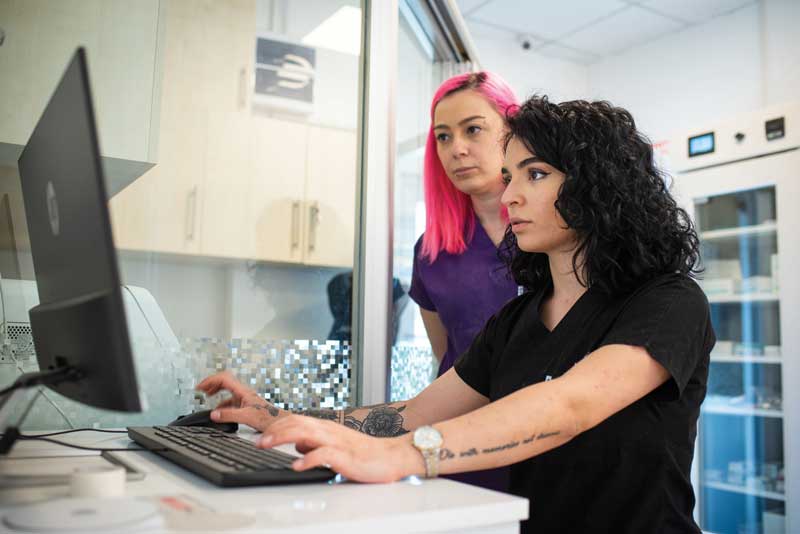
I recently attended the mid-year VetPartners meeting, where one of my veterinary heroes shared that the ability to be adaptable is the greatest indicator of success. I could not agree more.
Medical breakthroughs, the rapidly changing world of technology, and even consumer attitudes, change at the speed of lightning. Veterinary medicine must focus on staying agile to keep on top of the public’s demands.
Reluctance to change is almost a running joke when referencing the veterinary profession. Busy doctors and staff are often just working through their day to survive. It takes time, focus, and interest to put in the effort to make a change when it appears the old way is working sufficiently. Even when we desire to make changes, something in our nature pulls us back into old habits and the new behavior fails.
Why is change so hard?
It has to do with the way our brains are wired. When we perform a task repeatedly, we develop a neuropathway, also known as a habit. These paths are extremely helpful for routine things such as brushing our teeth or driving to work. We can perform these tasks while simultaneously thinking about something complex. This is really the only way our brain is capable of multitasking since it is impossible to think about two non-routine things at the same time.
These pathways are permanent, and our brain wants to automatically default to them rather than the new path we desire to forge. If you have ever changed jobs and caught yourself driving to the old one by mistake, you have experienced a neuropathway.
In an article published in the Harvard Business Review,1 Erica Anderson stated for many previous generations, humans experienced little change from their parents and grandparents’ lives and cultures. They often were born, grew up, and died in the same house. Change was forced upon them if it occurred and was considered suspicious and even dangerous. Due to this pattern, our brains wired themselves to be wary of changes. Even when we want to change, such as quitting smoking or overeating, our wary brain pulls us back to the familiar.
Still, to be a good businessperson, a good practitioner, or a good staff member, the ability to keep current is imperative. We must embrace new ideas, even when it is uncomfortable to do so.
Any consultant can tell you getting a team to change a work pattern will get immediate push back. It may be verbal, but more often, is simply a passive-aggressive refusal to do anything differently.
Change Arc, a behavior pattern observed and coined by coaching, consulting, and leadership development training firm in the U.S., Proteus International, is helpful in understanding the challenge of change. It starts with stating the proposed change and answering these questions about it to the team:
- What is changing–for me?
- Why?
- What will it look like?
Typically, the team members will answer these questions for themselves with these responses:
- Change will make my life more difficult.
- This change will cost me something I value.
- This change will feel strange because that is not the way we do things here.
The training firm observed and documented that “people only begin to be open to accepting, embracing, and making a change when their mindset starts to shift from “this change is going to be difficult, costly, and weird” to “this change could be easy, rewarding, and normal.” Once someone starts to believe change could be easy (or at least doable) to make, the rewards of making the change will outweigh the costs.”2
How do we move people from reluctance to acceptance? We involve them in the change. A research study in 2015 by a consulting firm3 found 70 percent of change initiatives in companies fail; but they also point out that changes, where employees are involved, increase success by 30 percent.
Considering new ownership
Consider a practice that comes under new ownership. The new leader can dictate they will change computer systems, order different drugs, utilize a new phone system provider, and start a new dress code. All these things are reasonable adjustments to updating a practice that has stagnated under the past owner, but it is going to cause such great disruption that workflow will be hampered, and staff could quit because of the stress.
The wise new owner will gather the staff and ask them what their greatest frustrations are with the current system. Once they are discovered, sharing how the new tools, etc., can improve these frustrations will help the staff appreciate the discomfort needed to reach the agreed upon goals. Then, ask the staff which project should have priority. You may want to guide them to the simplest project first and get a quick and easy “win.”
Let’s break down a change using the Change Arc pattern from above. Perhaps your practice needs to move to a new PIMs provider. Changing software is always a difficult switch because the staff is comfortable with the current system and has developed “keystroke” neuropathways that make working in the system
a breeze.
So, the first question leaders need to address is, “What is changing for me?”
- Certainly, there will be a learning curve as new pathways have to be created to accomplish data entry. It is possible that some manual tasks will be replaced. Your work as inventory manager will change the way orders are placed from manual to digital.
Next is, “Why?”
- Because moving to this new system will be more efficient, it will integrate with a digital lab, x-ray and inventory ordering system and reduce errors, give us better medical records, automatically adjust drug pricing based on costs and reduce missed fees.
Finally, “What will it look like?”
-
-
- At first, it will be uncomfortable as we learn to create a new workflow and build different systems for charting, reminders, invoicing, and end-of-day and other reports. The screens will be different and the reports will have different names. The codes we use will be the same because they will transfer from the old system. All the clients and patients will transfer as will the medical history. Finding things we are used to looking up, may be different.
By shining a light on how the changes will occur, leaders reduce the fear of the new and unknown. Then they need to continue to the next step in the Change Arc, which is moving people from dread to excitement.
- How will we make this easy?
-
- Everyone on our team will help choose the software they feel is the best fit for our hospital—within reason. Financial constraints must be considered, but we will all discuss our options together. Then each member of the team will be allowed paid time on the schedule to learn the new software. We will choose certain modules for different team members to dive deeper into so they can be the expert on that section and help others. We will bring in an expert to help with setup and training and we will connect with online user groups for extra support.
What about my personal cost? I am a whiz at our old system and everyone comes to me for help. I like being the expert!
-
- Your knowledge of the old system will be valuable as we transition to the new one. We will have you work closely with the integration team to make sure all the important things you know and use are transferred. We will have you continue to be the expert in our new system.

Transparency about the learning curve and potential challenges in using a new system in the practice can help address the team’s frustrations around it; hear them out with any concerns. Embracing change can take longer for some people.
- At first, it will be uncomfortable as we learn to create a new workflow and build different systems for charting, reminders, invoicing, and end-of-day and other reports. The screens will be different and the reports will have different names. The codes we use will be the same because they will transfer from the old system. All the clients and patients will transfer as will the medical history. Finding things we are used to looking up, may be different.
This is going to be very disruptive and what is the value to me to be so uncomfortable and to have to learn something completely different. We have been doing just fine as we are.
-
-
- Changing to new software will ultimately make our work easier. Many of the tasks we perform daily take much longer than necessary because of the old design of our system. When we can automatically integrate our digital diagnostic tools into the new software this will save you the boring and tedious task of scanning results. We also want to afford increases in salary for our team members so saving time and capturing fees better will help us do so. Since you are proficient with what we have, with your skills I know you will be an expert in no time.
-
Now that we have addressed the questions with reasonable plans and truthful answers the mindset of the staff member is moving into acceptance and positivity that the change will be an improvement, not just to the practice, but also for their personal work tasks. This way when the person tends to fall back into old ways or complains about learning the new software, leaders can provide instant feedback that they were informed of the challenges and the plan and agreed to be onboard. When the team gets a voice, changes are more readily accepted.
These same questions can be answered in our personal lives when we desire to make changes for our personal health and well-being. The ability to embrace the new and unfamiliar is truly a superpower. Exercise your “change” muscles, involve your team, be excited about the possibilities, and soar!
Debbie Boone, BS, CVPM, Fear Free Certified, has worked in the veterinary profession for more than 35 years. Boone has experience in the management of small animal, mixed animal, specialty, and emergency practices. Her business, 2 Manage Vets Consulting, helps practices develop team communication and business skills, enhance patient care, improve profitability, and increase practice value. Boone strives to improve the lives of animals by using her expertise to improve workplace culture and the well-being of veterinary professionals. She lives in North Myrtle Beach, S.C., where she spends her off-time in her garden, at the beach, or on the boat.
References
-
- https://hbr.org/2022/04/change-is-hard-heres-how-to-make-it-less-painful?autocomplete=true
- Andersen, E. 2021. Change from the inside out: making you, your team, and your organization change-capable.
- https://www.mckinsey.com/featured-insights/leadership/changing-cha
-
